mobile Ansicht, to the English Version tap the flag
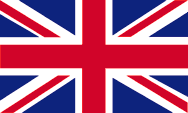

- ehemaliges Emirat, Sultanat und Königreich in Zentralarabien
- heute zentraler Landesteil von Saudi-Arabien
• Flaggen
• Bedeutung/Ursprung der Flagge
• Landkarte
• Zahlen und Fakten
• Geschichte
• Ursprung des Landesnamens
Ein besonderes Merkmal der Flaggen auf dieser Webseite ist eine Inschrift mit arabischer Schrift. Im europäischen Verständnis wird jede Inschrift auf einer Flagge auf der Vorderseite der Flagge betrachtet, die Schrift immer von links nach rechts laufend, so dass die jeweilige Inschrift neben dem links stehenden Mast beginnt und nach rechts – in Richtung wehendes Ende der Flagge – weiterläuft. Die arabische Schrift wird aber von rechts nach links gelesen. Die europäische Betrachtungsweise sollte nicht auf Flaggen mit arabischen Inschriften übertragen werden, denn wäre der Mast links, würde die arabische Schrift vom wehenden Ende zum Mast hin laufen, was nicht sein darf. Manchmal wird dieses Argument noch von Abbildungen verstärkt, z.B. ein Schwert, dessen Schwertspitze in Richtung Ende der Schahada zeigt. Will man das auf dieser Art Flaggen richtig zeigen, muss die Schrift vom Mast weglaufen, arabisch von rechts nach links, das Schwert dann ebenfalls von rechts nach links zeigen, wodurch der Mast zwingend rechts stehen muss. Um diese Art Flaggen richtig zu verwenden, müssen zwei Vorderseiten gegeneinander genäht werden, ein spiegelverkehrter Durchdruck wäre nicht anbracht.

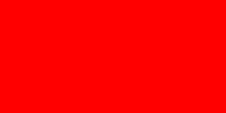
1727–ca.1750,
Scheichtum Darija,
Flagge des Scheichtums Al-Darija,
Quelle, nach: World Statesmen



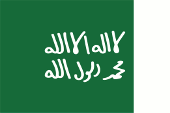

ca.1750–1818,
Emirat Darija,
Flagge des Emirats Al-Darija,
Quelle, nach:
World Statesmen





ca.1824–1887,
Emirat Nedschd,
Flagge des Emirats Nedschd,
Quelle, nach:
World Statesmen



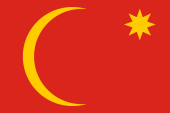
1836–1921,
Emirat Dschebel Shammar,
Flagge des Emirats Dschebel Shammar,
Quelle, nach:
World Statesmen



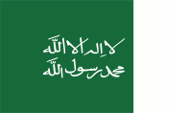

1902–1913,
Emirat Nedschd,
Flagge des Emirats Nedschd,
Quelle, nach:
World Statesmen



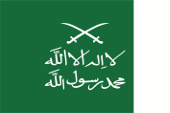

1913–1921,
Emirat Nedschd,
Flagge des Emirats Nedschd,
Quelle, nach:
World Statesmen



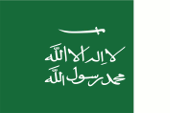

1921–1926,
Sultanat Nedschd,
Flagge des Sultanats Nedschd,
Quelle, nach:
World Statesmen



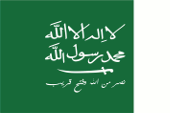

1926–1932,
Königreich Hedschas und Nedschd,
Flagge des Königreichs Hedschas und Nedschd,
Quelle, nach: Wikipedia (EN), SALEM,
Public domain, via Wikimedia Commons




Die Flagge des Emirats Al-Darija war ursprünglich wahrscheinlich einfarbig rot, ein in dieser Gegend übliches und durchaus weit verbreitetes Flaggenbild. Im 18. Jahrhundert gründete Ibn Abd al-Wahhab (1720–1792) eine islamisch-sunnitische Bewegung, die später nach ihm benannt wurde, die Wahhabiten. Er missionierte in Nedschd, und gewann ab 1745 großen Einfluss auf die Familie Saud, die Herrscher des Scheichtums Al-Darija. Diese Familie übernahm vollständig die Symbolik der Wahhabiten (die Farbe Grün, die Schahada und zeitweise sogar den Halbmond), so dass diese Symbolik im 20. Jahrhundert zur Heraldik des Königreichs Nedschd und später auch des Königreichs Saudi-Arabien wurde. Die Schahada ist das das Bekenntniswort des Islam: "Allah il Allah, wa Muhammad rasul Allah" → "Es gibt keinen Gott ausgenommen den Gott; Mohammed ist Allahs Gesandter". Im Jahre 1887 wird das Emirat Nedschd wird durch die Schammar-Stämme erobert. Als das Emirat Nedschd im Jahre 1902 neu gegründet worden war, wurde die alte Flagge wieder eingeführt. Zwischen 1926 und 1932 wurde noch ein weiterer arabischer Schriftzug unterhalb des Schwertes auf der Flagge gezeigt. Er lässt sich folgendermaßen übersetzen: "Sieg mit Gott, Islamisierung aller Länder". Die Farbe Grün war die Farbe des Mantels des Propheten Mohammed. Seinerzeit war es (auch in Europa) manchmal üblich Kleidungsstücke als Flagge zu verwenden. So auch beim Mantel von Mohammed. Die Farbe des Mantels wurde so sehr schnell zu Farbe und Flagge des Islam, und speziell zur Farbe der Fatimiden, einer ismailitisch-schiitischen Kalifendynastie, die auf den vierten Kalifen Ali, und Fatima, die Tochter Mohammeds zurückgeht. Das Schwert wurde 1913 in die Flagge aufgenommen und bezieht sich auf den Staatsgründer von Nedschd Ibn Saud Abdul-Asis III. (1880–1953). Es versinnbildlicht die militärischen Triumphe des Islam, der Familie Saud und der Wahhabiten. Es steht für Gerechtigkeit und Rechtschaffenheit.
Quelle: Wikipedia (EN), Die Welt der Flaggen, Volker Preuß

Die Arabische Halbinsel um 1920, interaktive Landkarte:
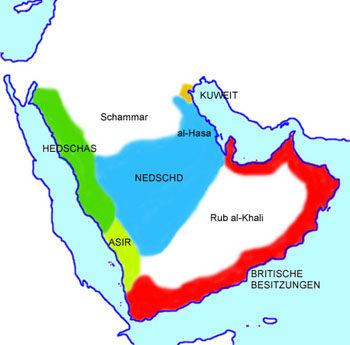
Quelle/Source: Volker Preuß

Fläche: ca. 1.390.300 km²
Einwohner: 3.500.000 (heute)
Hauptstadt: Riad (Ar Rijad)
Quelle:
Encyclopédie Universelle

15. Jahrhundert · Herausbildung des Scheichtums Al-Darija unter der Dynastie der Saud bei Riad
1744 · Emir Mohammed Ibn Saud von Al-Darija (1726–1766) nimmt den streng religiösen Scheich Mohammed Ibn Abd al-Wahhab (1720–1792) bei sich auf (al-Wahhab ist der Gründer der religiösen Bewegung der Wahhabiten), dieser gewinnt großen Einfluss auf Emir Mohammed Ibn Saud, Al-Darija wird zum Emirat und Wahhabitenstaat
1773 · Eroberung von Riad durch die Saudi-Wahhabiten
1788 · ganz Zentralarabien ist in der Hand der Saudi-Wahhabiten
1801 · Saudische Truppen erobern Kerbela
1806 · Saudische Truppen erobern Mekka
1812 · Mohammed Ali, der Osmanische Vizekönig von Ägypten, beginnt mit der Bekämpfung der Wahhabiten
1818 · Zerschlagung des Saudischen Wahhabitenstaats durch Mohammed Ali
1824 · die Saudis erobern Riad und gründen das Emirat Nedschd
1887 · das Emirat Nedschd wird durch die Schammar-Stämme erobert
1902 · die Saudis erobern Riad und gründen das Emirat Nedschd erneut
1891 · Aufstand der Saudis gegen die Schammar, Niederlage, Flucht der Familie Saud nach Kuweit
1902 · Emir Ibn Saud Abdul-Asis III. gelingt die Eroberung von Riad mit Unterstützung des Emirs von Kuweit, Einigung der Stämme des Nedschd unter den Saud
1909 · das Osmanische Reich erkennt die Herrschaft von Ibn Saud Abdul-Asis III. im Nedschd an
1913 · Saudische Truppen erobern die osmanische Küstenprovinz Al-Hasa am Persischen Golf
1915 · Großbritannien erkennt die Herrschaft von Ibn Saud Abdul-Asis III. im Nedschd an, Friedensabkommen zwischen Nedschd und Großbritannien
1921 · Saudische Truppen erobern Schammar
22.08.1921 · Proklamation des Sultanats Nedschd, unter Sultan Ibn Saud Abdul-Asis III.
1921–1925 · Saudische Truppen erobern den Hedschas
1922 · Großbritannien verzichtet auf seine Einflusssphäre in der Wüste Rub al-Khali
02.12.1922 · Errichtung einer neutralen Zone zwischen Nedschd und Kuweit, sowie zwischen Nedschd und Irak
1926 · Grenzvertrag mit Irak und Transjordanien
1926 · Krönung von Sultan Ibn Saud Abdul-Asis III. zum König von Hedschas
19.01.1927 · Krönung von Ibn Saud Abdul-Asis III. zum König von Nedschd und Hedschas
18.09.1932 · Gründung des Königreichs Saudi-Arabien durch Vereinigung des Königreichs Hedschas mit dem Königreichs Nedschd
Quelle:
Wikipedia (DE), World Statesmen,
Weltgeschichte, Volker Preuß

"Nedschd" ist Arabisch und heißt "Hochland". Damit ist die bergige Landschaft gemeint, die zwischen dem Dschebel Schammar, der Wüste ad-Dahna, dem Hedschas und der Wüste Rub al-Khali gelegen ist. Einige Berggipfel erreichen Höhen bis 1000 Meter. Es gibt einige Oasen und sporadische Wasserläufe.
Quelle:
Wikipedia (DE)


![]()


























